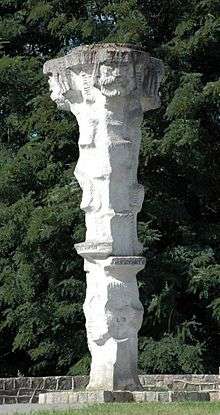Triglav (mythology)
Triglav (Church Slavonic: Триглав, lit. 'three-headed one'; Latin: Triglau), also sometimes called Troglav, is a deity in Slavic theology.
| Triglav | |
|---|---|
Statue of Triglav in Wolin, Poland | |
 |
Mount Triglav, the highest mountain in Slovenia, is unlikely to have any connection to the Slavic deity Triglav.[1] However, such a claim is made for Mount Troglav, the highest peak of Dinara in Bosnia and Herzegovina.[2]
Triglav is allegedly depicted as representation of three major Slavic gods that vary from one Slavic tribe to others that serve as the representatives of the above-mentioned realms. An early variation included Svarog, Perun, and Dazhbog. Later, Dazhbog was replaced by Svetovid or Veles. Triglav is usually described as a fusion of these gods. Triglav is depicted as a three-headed man sometimes with bands of (gold) blindfolds over his eyes, or a man with three goat heads. Several temples dedicated to Triglav existed near present-day Szczecin, Poland. The Polish village of Trzygłów (German: Trieglaff) is where, according to Johannes Bugenhagen in his Pomerania (1517) an image of Triglav was buried in the village to protect it from the priests of Otto of Bamberg in the 1120's.[3] During the period of Christianization, such temples and statues of Triglav were generally completely destroyed.
Three heads
According to the writing of Ebbo, Triglav's heads were believed to represent sky, earth and the underworld. It was believed that Triglav has three heads because he ruled these three kingdoms and had a golden binding over his eyes and lips so he could not see people's sins nor speak about them.[4]
See also
- Svetovid, an early Slavic deity with four heads
- Trimurti
- Dattatreya
References
- Snoj, Marko (2009). Etimološki slovar slovenskih zemljepisnih imen. Ljubljana: Modrijan. p. 439.
- "Troglav". Summitpost.
- Thadden, Rudolf von (2013). Trieglaff: Balancing Church and Politics in a Pomeranian World, 1807-1948. Berghahn Books. ISBN 9780857459282. Retrieved 23 July 2018.
- Ebbo, Vita Ottonts episcopi Bambergensis. III, 1. Ed. Jaffe, Monumnta Bambergensia (Bibliaiheca rerum Germamcarum 5, 1869) P. 580-692; ed. Wikarjak-Liman, Manumenta Poloniae historica, ser. novas 7, 2 (1969).
- Stetin vero, amplissima civitas et major Iulin, tres momntes ambitu suo conclusos habetat. Quorum medius qui et alcior, summo paganorum deo Trigelawo dicatus, tricapitum habebat simulacrum, quod aurea cidari oculos et labia contegebat; asserentibus ydolorum sacerdotibus: ideo summum deum tria habere capita, quoniam tria procuratet regna, id est celi terre et inferni; et faciem cidari operire pro eo, quod peccata hominum, quasi non videns et tacens, dissimularet. Hac itaque potentissma civitae ad veri Dei agnicionem per beatum presulem adducta, delubra ydolorum flammis erant absumpta, dueque ecclesie, una in monte Trigelawi sub honore sancti Adelberti, alia extra civitatis menia in veneratione ancti Petri erant locate. Et ex hoc sacrificia, que copioso apparatu et diviciis sacerdotibus fanisque ydolorum exhibebantur; nunc ecclesie Christi vendicabant.
External links
